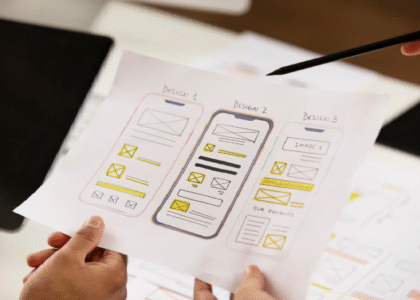Building a proper internet presence requires a professional-looking website for almost every modern company, organization, or person. First, a website is a primary tool through which a brand interacts with its stakeholders, meaning that its design plays a crucial role. A good website is, therefore, more of a brand than merely a figure of beauty. It involves the use, utilization, content provision and flexibility. In this blog post, the reader will learn the essential elements of good website design and how they help provide a practical and exciting experience.

ADVERTISEMENT
The Importance of Usability
- Intuitive Navigation
Of all the elements of web design, the most crucial role is played by the ease of website navigation. The items and materials concerning the center and the services it offers should be easily locatable and easily accessible. Thus, it is necessary to present a well-structured menu, suitable labels, and a proper information hierarchy. Stick to the familiar layout, like the top or the side menu, and add a search bar for users’ comfort. Users can also discern their position on the site, and if needed, they can always trace their steps.
- Consistency
After work, using the same fonts, colors, and button styles makes the work appear professional and less messy. Coherency benefits the user because finding what they are looking for requires less effort within a given site. It also reminds the viewer about the brand, strengthening the site’s brand image. It will help guarantee that all pages look alike and that the inputs and outputs will feel alike, too.
- Accessibility
Another principle of good Website design is called accessibility. Web accessibility means that people with disabilities should have equal access to Internet resources as any other users. It means that appropriate HTML tags and detailed image descriptions should be added, and the site should be accessible only by keyboards. WCAG 2, Web Content Accessibility Guidelines assist in the formulation of registering an account of such an accommodative experience. Extra options like changing the text size using an ‘easy on the eyes’ high contrast mode or maybe even integrating the support for screen readers will get your site in front of a wider audience.
ADVERTISEMENT
Aesthetics and Visual Appeal
- Visual Hierarchy
It creates a perception that some items on a page are more important than others. This principle assists in pointing the users’ attention towards the most pertinent sections of a website. Size, color, contrast, spacing – all these should be used to identify elements’ hierarchy. It is more suitable for headlines to be more significant than the body texts and for primary CTAs to be larger than the secondary ones. White space is also essential for creating well-proportioned, neat work while minimizing clutter.
- Typography
The font type or style, or typography, is vital in the website’s presentation and usability. Select the font that is easy to read and corresponds to the company’s image or a specific project. Choose a maximum of two typefaces or three for the flyer and poster designs as the subsequent portions of text. It is because small fonts may look large on desktops but very small on mobile devices if the resolution is high; different fonts for the body text and headings and spaces between lines and letters may look different on other devices due to their resolution and dpi. Repetition is good when used in typographical aspects as it creates a steady flow in articles and magazines to the reader.
- Color Scheme
Proper color choice plays a significant role in improving a website’s attractiveness and brand image. Choose one of the primary colors and add the secondary and accent colors. Maintain the consistency of the site’s colors to give it a harmonized appearance. Consider the psychological features of colors and their effect on users’ attitudes and activities. Make text and background colors contrasting so readers can easily read the text, and use color to guide attention to essential parts.
ADVERTISEMENT
Responsiveness and Mobile Compatibility
- Mobile-First Design
So, it becomes necessary to design a mobile-first website, mainly when mobile devices are widely used. The mobile-first approach guarantees that your site will be optimised from a functional and aesthetic perspective for mobile device use. Employ responsive design procedures to change the page format and the display size of the content. Improve the sense of direction, employ friendly and easily clickable elements to interact with and ensure that there is good typography with readable fonts and images. A site that is easily accessible on a mobile makes using the site on different devices friendly.
- Fast Loading Speed
The loading speed of a website is essential to the user and to ranking it in search engines. Usually, consumers desire and anticipate that websites should open as quickly as possible and, in most cases, may leave a site if the page is slow to load. Reduce the size of images and avoid using too many scripts and codes to enhance the loading rate among the browsers. Use the amount of large files scanned and decrease the time of the server’s response. Some standard tools, such as Google PageSpeed Insights, can tell how to make the site load faster.
- Cross-Browser Compatibility
Your site must be compatible with all browsers and portable devices. To check compatibility, you should have your site tested on Chrome browser, Firefox, Safari, and Edge. Make sure that any problems that are observed during testing, as well as any other disparities, are solved. Select current web standards and do not focus on outdated ones. Cross-browser compatibility makes use of any browser challenging for users to predict and address issues within websites or applications.
ADVERTISEMENT
Conclusion
Web design, therefore, is an art and a science since one has to take into consideration the usability, the looks, the contents, and the responsiveness of the site. Thus, intuitive navigation, consistency, web accessibility, visual priorities, fonts, colours, exciting content, responsive design, fast page speed, and cross-browser compatibility enable one to design a good-looking website with an excellent UI/UX. It is easy to agree that every website should be appropriately designed to attract and maintain visitors, gain their trust, and fulfil your online objectives. You can dedicate your resources to these basic principles to make your website shine in Internet businesses.
ADVERTISEMENT






